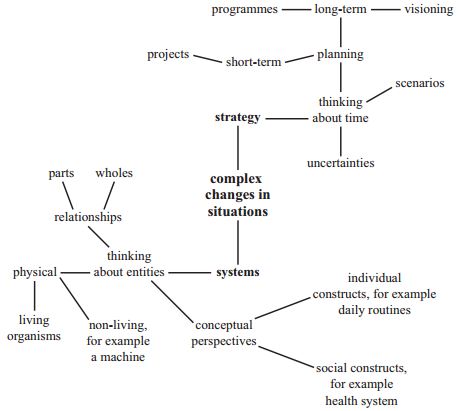1 Strategy making: bells that still can ring
Ring the bells that still can ring
Forget your perfect offering
There is a crack in everything
That's how the light gets in
I first read this verse written by Canadian songwriter and poet Leonard Cohen in a small book called Inside Out (Huston, 2007, p. 8), written by an experienced systems practitioner called Tracy Huston. The book has the subtitle Stories and Methods for Generating Collective Will to Create the Future We Want. It is about strategic thinking and planning for the future. Huston focuses on how to generate meaningful organisational change by drawing upon existing untapped internal human resources rather than continually seeking external answers.
Activity 1 Systems approaches
Now read sections 1.1, 1.2.8 and 1.2.9 of Introducing systems approaches [Tip: hold Ctrl and click a link to open it in a new tab. (Hide tip)] by Martin Reynolds and Sue Holwell.
Make brief notes on the three generalised purposeful orientations of systems thinking (section 1.2.8 in the reading), and align each of the five approaches in terms of their original orientations.
Discussion
The three orientations and historic alignment of each systems approach can be described in terms of:
- understanding inter-relationships: system dynamics and the viable systems model
- engaging with multiple perspectives: strategic options development analysis and soft systems methodology
- exploring and reconciling power relations (reflecting on boundaries): critical systems heuristics.
When I read Huston’s book, the words in Cohen’s verse captured for me something of the importance behind the five systems approaches as a collection of tools for thinking strategically about managing complex situations of change and uncertainty. I think bells ringing conveys the idea of tradition and I imagine each bell having its own distinct sound. Bells that still can ring are perhaps like a set of durable and well-used tools.
The five approaches collectively provide significant tools of the trade in systems thinking and systems practice. Each approach embodies at least 30 years of experiential use – 30 years of road-testing. They are the ‘bells that still can ring’, with a pedigree of time and experience. Over that period, challenges have exposed new offerings, insightful ways on how better to use these approaches in the light of invaluable experience.
The five systems approaches are presented not as new tools to replace old tools, but as composite tool sets that have been adapted to deal with different contexts and changing circumstances. The tools embedded in these approaches represent an invaluable resource for systems practice.
There are two dimensions of learning in this course:
- The first, the Tools dimension, briefly introduces five systems approaches – the bells that ring. The five approaches are:
- a.system dynamics (SD)
- b.viable system model (VSM)
- c.strategic options development and analysis (SODA)
- d.soft systems methodology (SSM)
- e.critical systems heuristics (CSH).
- The second, called the People dimension, explores some of the more personal aspects behind users of the tools embedded in the systems approaches. These are people like you and me who humbly may have no delusions of making what Leonard Cohen called a ‘perfect offering’ but nevertheless are wanting to make better offerings than at present in an imperfect and often bewildering world.
How do these five approaches help with thinking strategically? And why these five approaches in particular? A good place to start in answering these questions would be in clarifying the meaning of the words ‘strategy’ and ‘systems’. The two words may already be familiar to you. But in what way might they be used together? How might they complement each other?
Activity 2 Systems and strategy
Make some brief notes, and drawings if you wish, on what the words ‘strategy’ and ‘systems’ mean to you. Do this as a brief brainstorming exercise, noting down any word associations or images that come to mind in relation to each term.
Discussion
In doing this exercise, for strategy I made the following word associations: process, futures, scenarios, forecasting, scripts, and planning. For systems, I noted words like entities, things, ideas, constructs, hindrances, opportunities, plans, checklists.
A simple distinction that came to my mind is that whereas strategy suggests a time element – the future – systems typically suggests more physical or observable elements that occupy some kind of space that might be used, modified and adapted.
Figure 1 provides my own distinctions between the terms strategy and systems.

Spray diagrams are the same as what you may know of as mind maps. As with other systems diagrams, the spray diagram allows the relationships between parts of the situation to be seen at the same time as the parts themselves. In examining Figure 1 you may wish to add other ideas or make your own links between parts. For example you may consider that systems are also about processes or you may feel that strategy requires something about purpose. Feel free to add your own ideas to the diagram.
